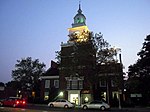Parkway Village (Queens)
Kew Gardens Hills, QueensNational Register of Historic Places in Queens, New YorkResidential buildings on the National Register of Historic Places in New York CityRobert Moses projects

Parkway Village is a garden apartment complex with 675 residential units, located on 35 acres (14 ha) in the Briarwood section of Queens in New York City. It was completed in 1947 to house United Nations employees and delegates, many of whom had faced racial discrimination when they sought housing in other areas.
Excerpt from the Wikipedia article Parkway Village (Queens) (License: CC BY-SA 3.0, Authors, Images).Parkway Village (Queens)
Village Road, New York Queens
Geographical coordinates (GPS) Address Nearby Places Show on map
Geographical coordinates (GPS)
| Latitude | Longitude |
|---|---|
| N 40.717222222222 ° | E -73.812777777778 ° |
Address
Village Road 147-35
11435 New York, Queens
New York, United States
Open on Google Maps










